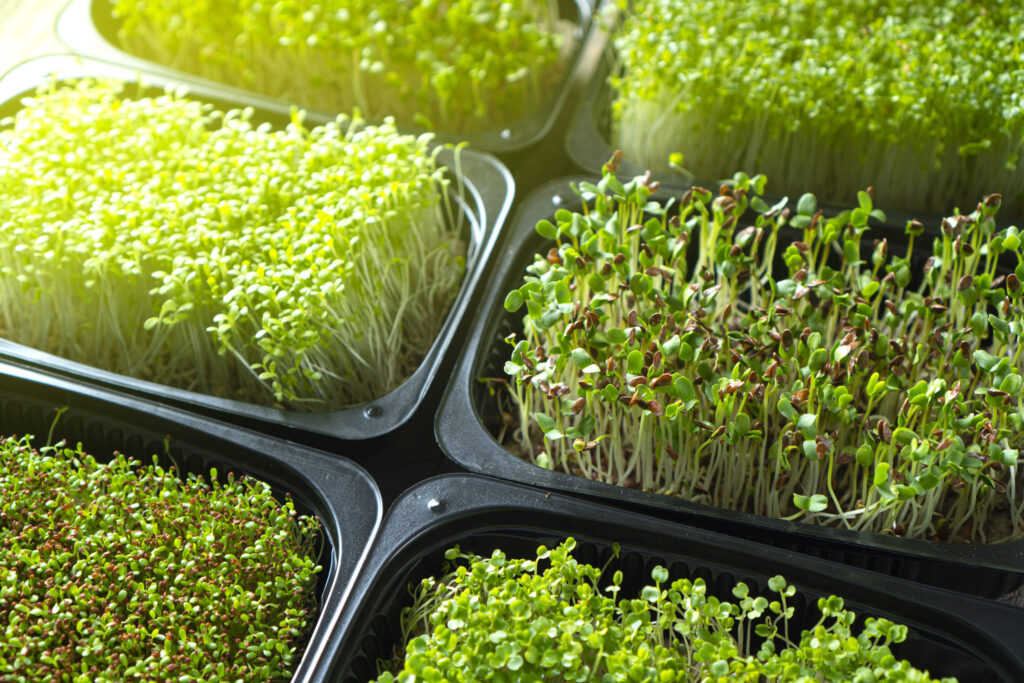Grow Your Own Microgreens and Enjoy its Benefits!
The world is now seeing an increase in the trend of growing their own Microgreens. In recent years, microgreens have taken over many gardens, be it, your small window kitchen garden or a chef’s big garden in a restaurant. And, this is all thanks to its ease of growing and high nutritional value, complementing the flavour and the look of the dishes.
Being intrigued by microgreens and their advantages, I also followed the trend and grew a few microgreens in my kitchen. Growing microgreens, enjoying their taste in salads and their benefits made me want to share all about microgreens with you all…
So without wasting time, let me share some insights on the wonders of Microgreens…
What Are Microgreens?
Microgreens, also known as “vegetable confetti”, are tiny versions of leafy vegetables (they are approximately 2.5-7.5 cm (1–3 inches) tall) that take about 1-3 weeks to grow. These microgreens are tender shoots of a vegetable or herb plant that are consumed at the cotyledon stage, once the first true leaves appear.
Microgreens are also considered baby plants, which fall in the range of sprouts and baby greens. But friends, do not mistake them for sprouts. These are very different from sprouts due to their growing method. Microgreens do grow from sprouts, but they have leaves.

Is smaller better?
- Microgreen are nutrient-concentrated and thus have an amazing health benefits.
- In a research comparing microgreens to more mature greens, it stated that nutrient levels in microgreens can be up to 9 times higher than those found in mature greens.
- They are full of healthy enzymes and also are a rich source of micronutrients, polyphenols.
- Polyphenols in microgreens are linked to lower the risk of heart disease.
- They are abundant in copper, magnesium, potassium, iron, zinc, and antioxidants.
- Antioxidant rich microgreens may lower the risk of different cancers and also lowers the chances of Alzheimer’s disease.
- The bacteria growth in microgreens is much smaller than in sprouts.
- Microgreens have an aromatic flavour and are found in a variety of colours and textures.
- Microgreen also have different tastes, they can be neutral, spicy, somewhat sour, or bitter.
- These greens are often used to dress the gourmet dishes and it brings out the added flavour required to elevate a dish.
Now, as I said earlier, they are pretty easy to grow in your kitchen window too. So, let us now see a step by step guide to growing our own microgreens…
How to grow your own Microgreens?
Starting with the Tools you Require:
- A container (you can use icream sundae box)
- Potting Soil
- Microgreen seeds
- Proper sun light (If you have a sunny, south-facing window available, then that’s the ideal light source.)

Now, Start your Microgreens Journey at Home:
- Add an inch of potting soil to your container and try to make it as even as possible.
- Scatter the microgreens seeds evenly across the surface of the soil.
- Now cover the seeds with a thin layer of soil (making sure that the seeds are not visible) and spray the surface with water.
- Time to place your container by your window or underneath a light source.
- Make sure to spray water on the soil as it should be evenly moist.
- It’s n ow time to wait for the microgreens to grow to their full 2 inches in two to three weeks.
Note: Want to grow more? You can remove the roots and replant them or dump the tray and start over again.
Grow You Own Microgreens At Home:
You will have a large variety to choose from. Microgreens can be grown from numerous types of seeds. And the most popular of those are:
- Sunflower Microgreens: A good source of Calcium, Iron, Vitamin A, B, C, D, and E
- Radish Microgreens: Rich in Manganese, Folate and Vitamins B3, B6, and C
- Pak Choi Microgreens: Contains Vitamins C, K, and E, Beta-carotene, and Iron
- Broccoli Microgreens: Rich in Vitamins A and C as well as Iron, Calcium, and Fibres. Broccoli microgreens also have a protein content of 35%
- Cabbage Microgreens: Contains good amount of useful antioxidants and Vitamin C, E and Beta carotene
- Spinach Microgreens: Filled with Vitamin A, C, K1, Folic Acid, Iron and Calcium
- Beetroot Microgreens: A good source of Vitamins A, B, C, E, and K, Iron, Calcium, and Protein. They also have a good supply of Magnesium, Potassium, and Copper
- Corn Microgreens: Contains Vitamins A, B, C and E, Calcium, Magnesium and are a rich source of Antioxidants.
Know more about microgreens to plant and buy them from All That Grows
How can I serve microgreens?

After a wait of 2-3 weeks, it’s finally time to harvest it and decorate your dish with microgreens. Do not forget to rinse them before serving them. Though there is hardly any chance of bacterial growth, but it is always better and advisable (especially during the covid season) to give a quick rinse.
You can incorporate microgreens in sandwiches, wraps and salads. You can also make your smoothie or juice healthier by adding a few microgreens. A few of the restaurateur also garnishes the pizza, curries or other warm dishes with microgreens, giving the dish a more elegant look and taste.
So, what are you waiting for, lets order some microgreens seeds and enjoy its many health wonders…

Stay Connected with 5pm Ardor for more such interesting blogs and Stay Healthy

